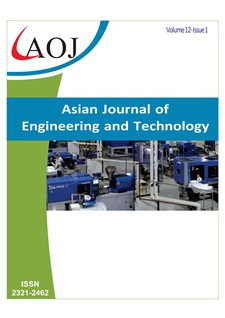Numerical Modeling, Analysis and Structural Design of G+4 RC Building with Re-Entrant Corners
DOI:
https://doi.org/10.24203/wpvg1q26Keywords:
Re-entrant corner, Horizontal irregularity, Equivalent static method, Response spectrum methodAbstract
The architectural design of structures like schools, offices, and hotels often features asymmetry and plan irregularities, demanding careful consideration during seismic analysis and structural design. Re-entrant corners with certain conditions in a building are considered a horizontal irregularity by seismic codes such as IS 1893 (Part I):2002. This study focuses on the analysis and design of a multi-storey office building situated in Zone V with a re-entrant corner horizontal irregularity. It encompasses the preliminary design of structural components and seismic analysis using a numerical model based on IS 1893 (Part I):2002, implemented in ETABS v20.0.0. Key responses, including time period, modal mass participation ratios, and storey drift ratio, are assessed to ensure compliance with codal requirements. Following this, structural design for beams, columns, and slabs is executed, and the required longitudinal and transverse reinforcement in different locations of these components is compared across various floors.
References
Gautam, D., & Chaulagain, H. (2016). Structural performance and associated lessons to be learned from world earthquakes in Nepal after 25 April 2015 (MW 7.8) Gorkha earthquake. Engineering Failure Analysis, 68, 222–243. https://doi.org/10.1016/j.engfailanal.2016.06.002
Arunraj, D., Sasirekha, V., Suganthi, M., Vidhya, K. V. K., & Manirasu, R. (2023). Seismic analysis and design of high-rise buildings by using ETABS in different seismic zones. AIP Conference Proceedings, 2782. https://doi.org/10.1063/5.0156164
Gaur, H., Goliya, R. ., Murari, K., & Mullick, A. K. (2014). A parametric study of multi-storey R/C buildings with horizontal irregularity. International Journal of Research in Engineering and Technology, 03(04), 360–364. https://doi.org/10.15623/ijret.2014.0304064
Shatnawi, A. S., Musmar, M., & Gharaibeh, L. I. (2018). Evaluation of seismic analysis procedures for concrete moment-resistant frames with horizontal re-entrant corner irregularity. International Journal on Advanced Science, Engineering and Information Technology, 8(3), 876–881. https://doi.org/10.18517/ijaseit.8.3.5851
MacLeod, I. A. (2014). Analytical Modelling of Structural Systems: An Entirely New Approach with Emphasis on Behavioural Modelling (1st edition ed.). London and New York: Routledge.
MacGregor, J. G. (1976). Safety and Limit States Design for Reinforced Concrete. Canadian Journal of Civil Engineering, 3(4), 484–513. https://doi.org/10.1139/l76-055/asset/images/l76-055c9.gif
Downloads
Published
Issue
Section
License
Copyright (c) 2025 Ashish Thapa, Sasishekhar Thapa, Kishan Thapa, Jeevan Gwachha

This work is licensed under a Creative Commons Attribution-NonCommercial 4.0 International License.
- Papers must be submitted on the understanding that they have not been published elsewhere (except in the form of an abstract or as part of a published lecture, review, or thesis) and are not currently under consideration by another journal published by any other publisher.
- It is also the authors responsibility to ensure that the articles emanating from a particular source are submitted with the necessary approval.
- The authors warrant that the paper is original and that he/she is the author of the paper, except for material that is clearly identified as to its original source, with permission notices from the copyright owners where required.
- The authors ensure that all the references carefully and they are accurate in the text as well as in the list of references (and vice versa).
- Authors retain copyright and grant the journal right of first publication with the work simultaneously licensed under a Attribution-NonCommercial 4.0 International that allows others to share the work with an acknowledgement of the work's authorship and initial publication in this journal.
- Authors are able to enter into separate, additional contractual arrangements for the non-exclusive distribution of the journal's published version of the work (e.g., post it to an institutional repository or publish it in a book), with an acknowledgement of its initial publication in this journal.
- Authors are permitted and encouraged to post their work online (e.g., in institutional repositories or on their website) prior to and during the submission process, as it can lead to productive exchanges, as well as earlier and greater citation of published work (See The Effect of Open Access).
- The journal/publisher is not responsible for subsequent uses of the work. It is the author's responsibility to bring an infringement action if so desired by the author.


